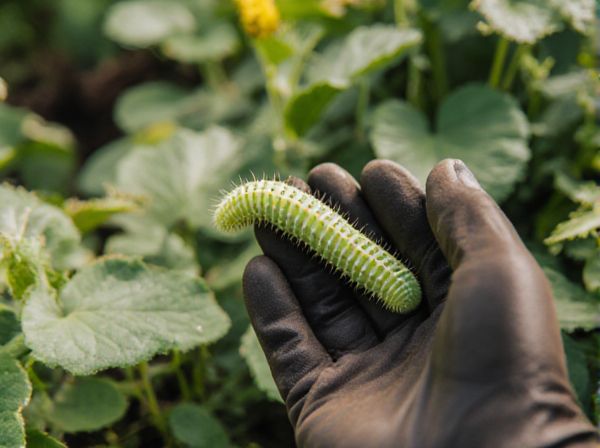
Lacewing larvae vs ladybugs Illustration
Lacewing larvae and ladybugs are both effective natural predators used in pest control, targeting aphids, mites, and other soft-bodied insects. Lacewing larvae are voracious feeders with strong mandibles, capable of consuming large numbers of pests rapidly, while ladybugs not only eat pests but also their larvae, contributing to long-term pest suppression. Selecting between lacewing larvae and ladybugs depends on specific pest species and environmental conditions in the garden or crop area.
Table of Comparison
| Feature | Lacewing Larvae | Ladybugs |
|---|---|---|
| Scientific Name | Chrysopidae (larval stage) | Coccinellidae |
| Primary Diet | Aphids, mites, scale insects | Aphids, scale insects, mealybugs |
| Predation Method | Active hunter, piercing mouthparts | Grazing, chewing mouthparts |
| Effectiveness | Highly effective on soft-bodied pests | Effective on aphids and pest eggs |
| Life Cycle | Egg - Larva - Pupa - Adult | Egg - Larva - Pupa - Adult |
| Habitat | Gardens, crops, natural vegetation | Gardens, farms, forests |
| Usage in Pest Control | Biological control agent for aphids and whiteflies | Natural predator used against aphids, scale insects |
| Appearance | Elongated body, large mandibles, translucent green wings as adults | Rounded, dome-shaped, red or orange with black spots |
Introduction to Natural Garden Pest Control
Lacewing larvae and ladybugs are effective natural predators used in garden pest control to manage aphids, mites, and other harmful insects. Lacewing larvae, often called "aphid lions," consume large quantities of soft-bodied pests, while ladybugs target similar prey and can rapidly reduce pest populations. Employing these beneficial insects promotes ecological balance and reduces the need for chemical pesticides in sustainable gardening practices.
Lacewing Larvae: Nature’s Voracious Predators
Lacewing larvae are highly effective biological control agents, preying on aphids, mites, and other soft-bodied pests with remarkable voracity. Their ability to consume hundreds of pest insects during their larval stage makes them invaluable for integrated pest management in agricultural and garden ecosystems. Unlike ladybugs, lacewing larvae are often considered more aggressive predators, increasing pest control efficiency without the use of chemical pesticides.
Ladybugs: Iconic Garden Defenders
Ladybugs, also known as Coccinellidae, are iconic garden defenders renowned for their voracious appetite for aphids, scale insects, and other common garden pests. With distinctive red or orange spotted elytra, ladybugs effectively reduce pest populations, promoting healthy plant growth without harmful pesticides. Their ability to consume up to 5,000 aphids in a lifetime makes them essential biological control agents in sustainable pest management.
Life Cycle Comparison: Lacewing Larvae vs Ladybugs
Lacewing larvae and ladybugs undergo complete metamorphosis, including egg, larva, pupa, and adult stages, but their development timelines vary significantly. Lacewing larvae typically complete their life cycle in about 4 to 6 weeks, rapidly progressing through their predatory larval stage, while ladybugs may take 3 to 4 weeks to develop but often have multiple generations annually. Both play crucial roles in natural pest control, with lacewing larvae being voracious predators of aphids and other soft-bodied insects, and ladybug larvae consuming similar prey throughout their development.
Pest Targets: What Do They Eat?
Lacewing larvae primarily target aphids, thrips, and whiteflies, making them effective predators of soft-bodied pests in gardens and agricultural fields. Ladybugs, especially in their larval and adult stages, predominantly consume aphids but also feed on scale insects, mites, and small caterpillars. Both predators play crucial roles in integrated pest management by naturally reducing populations of common garden pests.
Effectiveness in Controlling Aphids and Other Pests
Lacewing larvae are highly effective in controlling aphids, consuming up to 200 aphids during their larval stage, while ladybugs can eat around 50 aphids per day. Both predators target soft-bodied pests such as scale insects, mealybugs, and spider mites, but lacewing larvae tend to have a broader prey range including small caterpillars and eggs. When integrated into pest management, lacewing larvae offer a prolonged control period, whereas ladybugs provide rapid suppression due to their mobility and feeding capacity.
Environmental Impact and Sustainability
Lacewing larvae and ladybugs both serve as effective biological control agents against common garden pests, reducing the need for chemical pesticides and promoting sustainable pest management. Lacewing larvae consume a broader range of soft-bodied insects, offering more comprehensive pest control with minimal disruption to local ecosystems. Ladybugs, known for their voracious appetite for aphids, contribute to maintaining ecological balance by supporting biodiversity and reducing environmental pollution.
How to Attract Lacewing Larvae and Ladybugs
To attract lacewing larvae and ladybugs, cultivate a garden rich in flowering plants like dill, fennel, and yarrow that provide nectar and pollen. Introduce aphid populations as a natural food source to lure lacewing larvae, which are voracious predators of soft-bodied pests. Maintain a pesticide-free environment and offer shelter with mulch or ground cover to encourage ladybug habitation and reproduction.
Challenges and Limitations of Each Predator
Lacewing larvae, while highly effective against aphids and small soft-bodied pests, face challenges in controlling larger or hard-bodied insects due to their limited bite strength. Ladybugs excel at consuming a broader range of pests, including aphids and scale insects, but their effectiveness diminishes in cold weather and they may disperse quickly from treated areas. Both predators have limitations based on environmental conditions and prey availability, requiring integrated pest management strategies for optimal control.
Choosing the Right Ally for Your Garden
Lacewing larvae and ladybugs both serve as powerful natural predators for controlling aphids and other garden pests, but choosing the right ally depends on your specific pest problem and garden environment. Lacewing larvae are voracious feeders on a wide range of soft-bodied insects, making them highly effective in diverse pest scenarios, while ladybugs excel particularly in managing aphid populations quickly and efficiently. Consider the pest type, garden size, and climate to determine which beneficial insect will best support your integrated pest management strategy.
Lacewing larvae vs ladybugs Infographic

 gardendif.com
gardendif.com